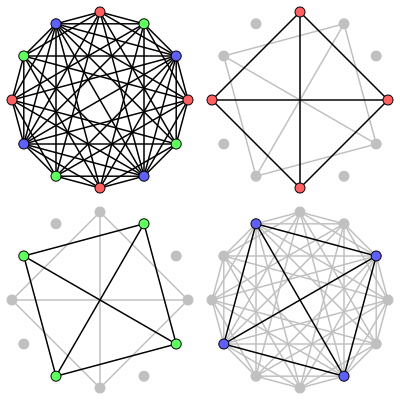
Cocoloring
Encyclopedia

Graph theory
In mathematics and computer science, graph theory is the study of graphs, mathematical structures used to model pairwise relations between objects from a certain collection. A "graph" in this context refers to a collection of vertices or 'nodes' and a collection of edges that connect pairs of...
, a cocoloring of a graph G is an assignment of colors to the vertices such that each color class forms an independent set in G or in the complement of G. The cochromatic number z(G) of G is the least number of colors needed in any cocolorings of G. The graphs with cochromatic number 2 are exactly the bipartite graph
Bipartite graph
In the mathematical field of graph theory, a bipartite graph is a graph whose vertices can be divided into two disjoint sets U and V such that every edge connects a vertex in U to one in V; that is, U and V are independent sets...
s, complements of bipartite graphs, and split graph
Split graph
In graph theory, a branch of mathematics, a split graph is a graph in which the vertices can be partitioned into a clique and an independent set...
s.
As the requirement that each color class be a clique or independent is weaker than the requirement for coloring
Graph coloring
In graph theory, graph coloring is a special case of graph labeling; it is an assignment of labels traditionally called "colors" to elements of a graph subject to certain constraints. In its simplest form, it is a way of coloring the vertices of a graph such that no two adjacent vertices share the...
(in which each color class must be an independent set) and stronger than for subcoloring
Subcoloring
In graph theory, a subcoloring is an assignment of colors to a graph's vertices such that each color class induces a vertex disjoint union of cliques....
(each color class must be a disjoint union of cliques), it follows that the cochromatic number of G is less than or equal to the chromatic number of G, and that it is greater than or equal to the subchromatic number of G.
Cocoloring was named and first studied by . characterizes minimal 3-cochromatic graphs, while describe algorithms for approximating the cochromatic number of a graph. defines a class of perfect cochromatic graphs, analogous to the definition of perfect graphs via graph coloring, and provides a forbidden subgraph characterization of these graphs.

